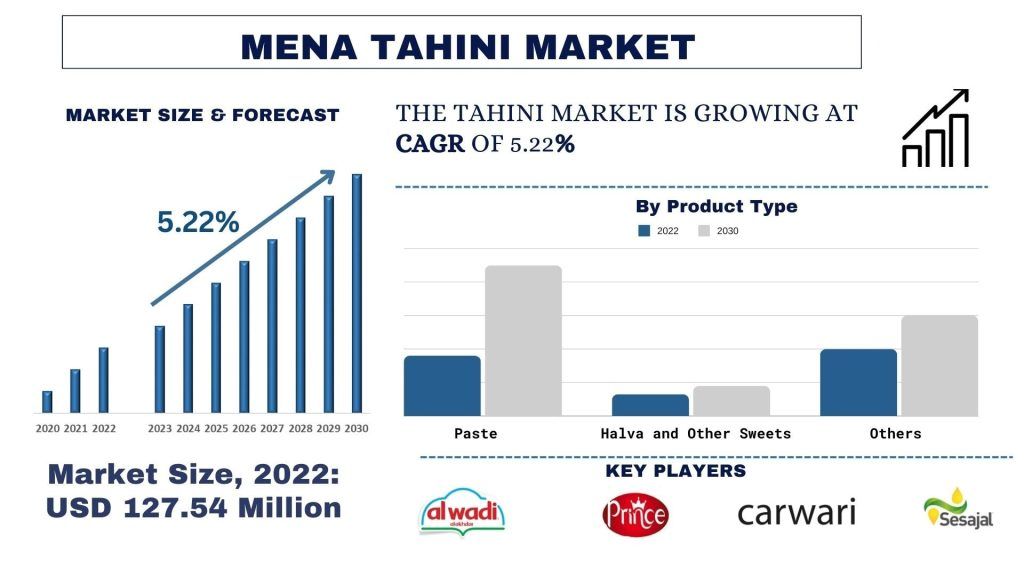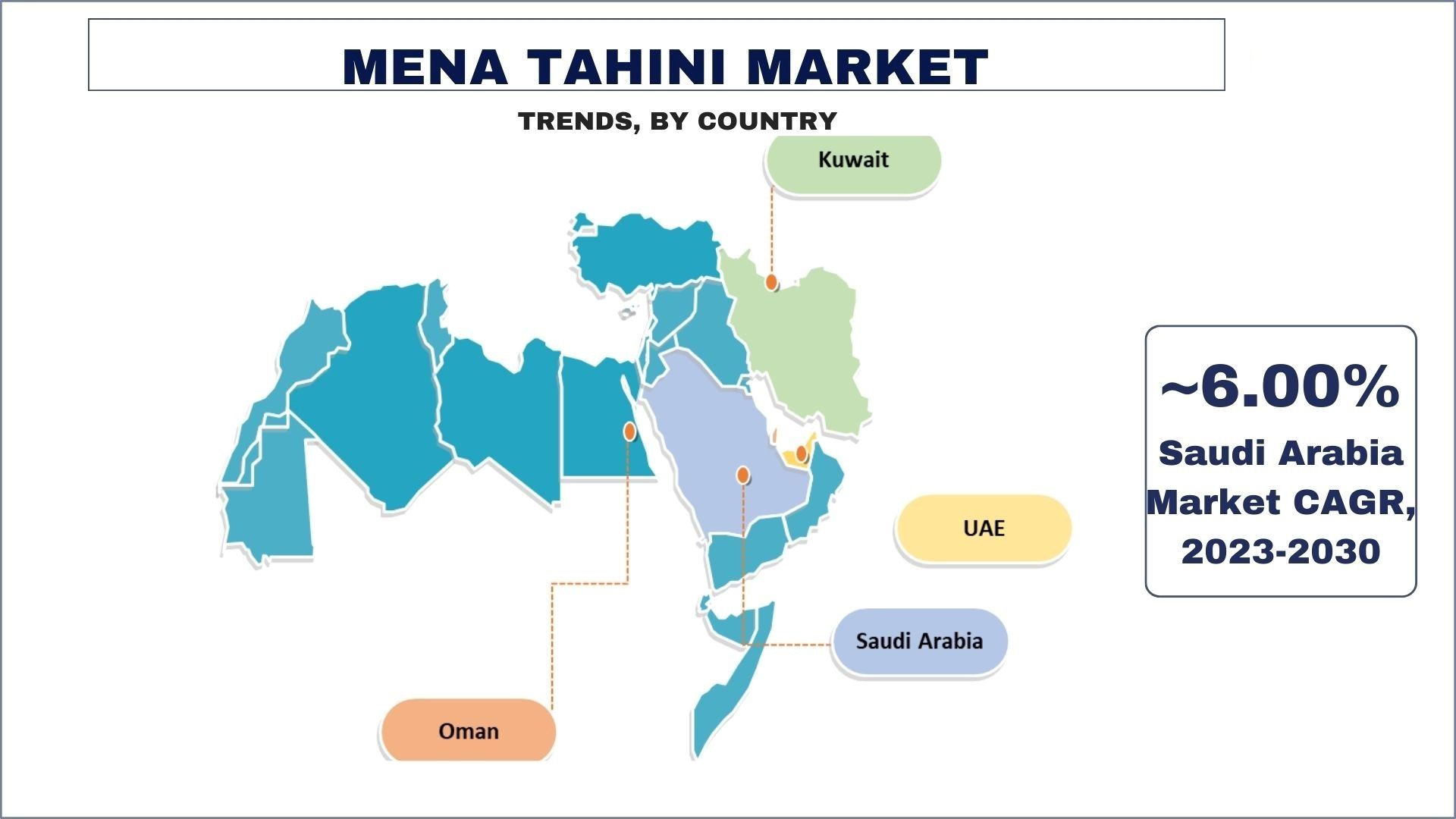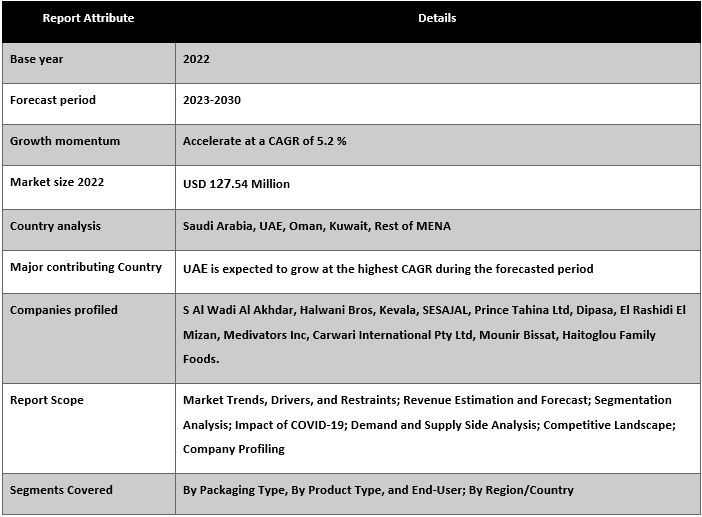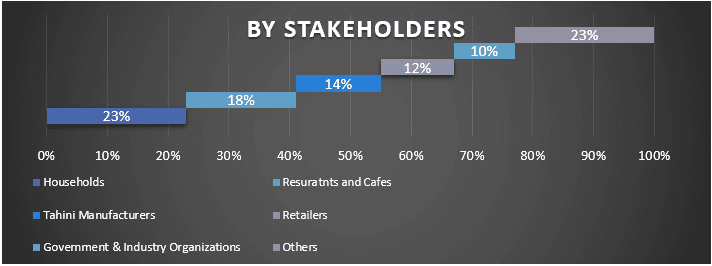MENA 芝麻酱市场:现状分析与预测 (2023-2030)
包装类型(瓶装、桶装、小袋装、罐装及其他);产品类型(膏状、哈尔瓦及其他甜食及其他);以及国家/地区

MENA Tahini 市场规模和预测
2022 年,MENA Tahini 市场估值为 1.2754 亿美元,预计在预测期内(2023-2030 年)将以 5.22% 左右的强劲复合年增长率增长。
MENA Tahini 市场分析
中东和北非 (MENA) 地区芝麻酱的采用显着增加,反映了根深蒂固的烹饪传统和对传统风味的日益欣赏。芝麻酱是中东和地中海美食中的主食,在该地区的美食景观中占据着受人尊敬的地位,其历史可以追溯到几个世纪前。然而,近年来,MENA 的芝麻酱市场出现了复苏,这得益于多种因素的推动,包括饮食习惯的改变、全球化的加剧以及植物性饮食的日益普及。随着消费者越来越注重健康并寻找有营养的替代品,芝麻酱成为一种多功能的成分,不仅味道鲜美,而且富含蛋白质、健康脂肪和矿物质等必需营养素。此外,人们越来越意识到芝麻酱的烹饪多功能性,这使得它被整合到各种菜肴中,而不仅仅是鹰嘴豆泥和巴巴甘努等传统美食,从而进一步扩大了它的吸引力和市场覆盖范围。
Al Wadi Al Akhdar、Halwani Bros、Kevala、SESAJAL、Prince Tahina Ltd、Dipasa、El Rashidi El Mizan、Medivators Inc、Carwari International Pty Ltd、Mounir Bissat、Haitoglou Family Foods 是主要的运营公司。这些企业已开展多项并购和合作,以便为客户提供高科技和创新产品/技术。

MENA Tahini 市场趋势
“在类型、包装类型中,芝麻酱市场分为瓶装、桶装、小袋装、罐装和其他包装。2022 年,罐装部分占据了重要的市场份额。”
根据包装类型,芝麻酱市场分为瓶装、桶装、小袋装、罐装和其他包装。2022 年,罐装部分占据了重要的市场份额。罐装芝麻酱的日益普及反映了烹饪界对便利性和质量的重视。罐装提供了一种实用的存储解决方案,其可重复密封的盖子可以保持芝麻酱的新鲜度和风味。它们的透明度使消费者可以在购买前评估产品的质量,从而增强对其真实性的信任。随着消费者在烹饪活动中寻求方便而优质的食材,芝麻酱罐装提供了一种多功能且营养丰富的选择,符合现代烹饪偏好。
“沙特阿拉伯在市场上占据主导地位。”
在沙特阿拉伯,随着该国拥抱其丰富的烹饪遗产并探索新的风味和食材,芝麻酱的采用一直在增加。芝麻酱的柔滑稠度和泥土味受到了欣赏传统中东菜肴(如芝麻酱、芝麻酱甜点和芝麻酱甜点)的沙特人的欢迎。沙特阿拉伯对健康饮食习惯日益增长的兴趣也促进了芝麻酱的普及,芝麻酱以其营养益处和在各种食谱中的多功能性而闻名。例如,根据阿拉伯巴西商会的报告,MENA 地区的有机食品市场正在经历每年 10% 到 25% 的增长率。这种增长主要归因于消费者健康意识的提高。凭借蓬勃发展的食品工业和对优质食材的偏爱,沙特阿拉伯为希望满足挑剔的消费者群体的芝麻酱生产商提供了一个充满希望的市场。沙特阿拉伯对芝麻酱日益增长的需求不仅限于传统菜肴;它也延伸到现代烹饪创作中。厨师和食品企业家正在尝试以创新的方式使用芝麻酱,将其融入冰沙、能量球甚至冰淇淋等现代菜肴中。随着消费者寻求将芝麻酱融入其饮食的新颖而令人兴奋的方式,这种趋势预计将持续下去。

MENA Tahini 市场报告覆盖范围

购买本报告的理由:
- 该研究包括经过认证的关键行业专家验证的市场规模和预测分析。
- 该报告快速回顾了整个行业的整体表现。
- 该报告深入分析了主要的行业同行,主要关注关键业务财务、产品组合、扩张战略和最新发展。
- 详细审查了行业中普遍存在的驱动因素、限制因素、关键趋势和机遇。
- 该研究全面涵盖了不同细分市场的市场。
- 深入分析了该行业的区域层面。
定制选项:
MENA Tahini 市场可以根据要求或任何其他细分市场进一步定制。除此之外,UMI 了解您可能有自己的业务需求,因此请随时与我们联系以获取完全满足您要求的报告。
目录
MENA 芝麻酱市场分析 (2023-2030) 的研究方法
分析历史市场、估算当前市场和预测 MENA 芝麻酱的未来市场是创建和分析 MENA 芝麻酱在主要国家/地区采用情况的三个主要步骤。 进行了详尽的二级研究,以收集历史市场数据并估算当前市场规模。 其次,为了验证这些见解,考虑了许多发现和假设。 此外,还与 MENA 芝麻酱价值链上的行业专家进行了详尽的一级访谈。 通过一级访谈对市场数据进行假设和验证后,我们采用了自上而下/自下而上的方法来预测整个市场规模。 此后,采用市场细分和数据三角测量方法来估算和分析行业相关细分市场和子细分市场的市场规模。 详细方法如下所述:
历史市场规模分析
步骤 1:深入研究二级来源:
进行了详细的二级研究,通过公司内部来源(如年度报告和财务报表、业绩演示文稿、新闻稿等)和外部来源(包括期刊、新闻和文章、政府出版物、竞争对手出版物、行业报告、第三方数据库和其他可靠出版物)获得 MENA 芝麻酱的历史市场规模。
步骤 2:市场细分:
在获得 MENA 芝麻酱的历史市场规模后,我们进行了详细的二级分析,以收集主要地区不同细分市场和子细分市场的历史市场洞察和份额。 报告中包含的主要细分市场包括包装类型和产品类型。 此外,还进行了国家/地区层面的分析,以评估该地区测试模型的总体采用情况。
步骤 3:因素分析:
在获得不同细分市场和子细分市场的历史市场规模后,我们进行了详细的因素分析,以估算 MENA 芝麻酱的当前市场规模。 此外,我们使用因变量和自变量(如包装类型和 MENA 芝麻酱的产品类型)进行了因素分析。 考虑到全球 MENA 芝麻酱行业的顶级合作伙伴关系、并购、业务扩张和产品发布,我们对需求和供应侧情景进行了全面分析。
当前市场规模估算与预测
当前市场规模:根据上述 3 个步骤的可行性见解,我们得出了当前的市场规模、MENA 芝麻酱的主要参与者以及细分市场的市场份额。 所有必需的百分比份额拆分和市场细分均使用上述二级方法确定,并通过一级访谈进行了验证。
估算和预测:对于市场估算和预测,权重被分配给不同的因素,包括驱动因素和趋势、限制因素以及利益相关者可获得的机会。 在分析这些因素后,应用相关的预测技术,即自上而下/自下而上的方法,以得出 2030 年主要市场不同细分市场和子细分市场的市场预测。 估算市场规模的研究方法包括:
- 该行业的市场规模,以收入(美元)和 MENA 芝麻酱在国内主要市场的采用率衡量。
- 市场细分市场和子细分市场的所有百分比份额、拆分和细分
- MENA 芝麻酱的主要参与者,就其提供的产品而言。 此外,这些参与者为在快速增长的市场中竞争而采取的增长战略。
市场规模和份额验证
一级研究:与主要地区的关键意见领袖 (KOL)(包括最高级别管理人员(CXO/VP、销售主管、营销主管、运营主管、区域主管、国家主管等))进行了深入访谈。 然后总结了一级研究结果,并进行统计分析以证明既定假设。 来自一级研究的投入与二级研究结果相结合,从而将信息转化为可操作的见解。
中东地区 MENA 芝麻酱市场的主要利益相关者

市场工程
采用数据三角测量技术来完成整体市场估算,并得出 MENA 芝麻酱每个细分市场和子细分市场的精确统计数据。 在研究包装类型和 MENA 芝麻酱产品类型领域的各种参数和趋势后,将数据分为几个细分市场和子细分市场。
MENA 芝麻酱市场研究的主要目标
该研究指出了 MENA 芝麻酱的当前和未来市场趋势。 投资者可以获得战略见解,以根据研究中进行的定性和定量分析来决定其投资。 当前和未来市场趋势决定了区域和国家/地区层面市场的整体吸引力,从而为行业参与者提供了一个利用未开发市场以受益于先行者优势的平台。 研究的其他定量目标包括:
- 分析 MENA 芝麻酱以价值(美元)计的当前和预测市场规模。 此外,分析不同细分市场和子细分市场的当前和预测市场规模。
- 研究中的细分市场包括包装类型和产品类型领域。
- 定义和分析 MENA 芝麻酱的监管框架
- 分析涉及各种中介机构的价值链,以及分析该行业的客户和竞争对手行为。
- 分析 MENA 芝麻酱在主要地区的当前和预测市场规模。
- 报告中研究的地区主要国家/地区包括沙特阿拉伯、阿联酋、埃及、土耳其和 MENA 其他地区。
- MENA 芝麻酱的市场概况以及市场参与者为在快速增长的市场中维持发展而采取的增长战略。
- 深入研究行业区域层面分析
常见问题 常见问题
Q1:MENA地区芝麻酱市场目前的市场规模和增长潜力如何?
Q2:MENA 芝麻酱市场增长的主要驱动因素是什么?
Q3:按包装类型划分,哪个细分市场在MENA芝麻酱市场中占有最大的份额?
第四季度:哪个国家将主导MENA芝麻酱市场?
Q5:MENA地区芝麻酱市场的主要参与者有哪些?
相关 报告
购买此商品的客户也购买了










